Adenium - a complete description of the plant
An unusual flower with a thickened trunk, branched crown and amazingly beautiful bright buds - this is all Adenium. It comes from Africa, where it grows in the driest regions. The poem is called "desert flower" or "Sudanese rose". The exotic plant has long been successfully grown in the homes of amateur florists around the world.
- Description of the plant
- Varieties
- Mini
- Crested
- Obese, or Somali
- Arabicum
- Socotransky
- Adenium Bema
- Purchase and adaptation
- Planting and transplanting
- Growing conditions
- Seat selection
- Humidity and temperature
- Illumination
- Home care
- Watering
- Fertilizers and feeding
- Features of winter care
- Reproduction methods
- Seeds
- Apical cuttings
- Air layering
- Caudex formation
- Pruning crown and roots
- Splicing multiple trunks
- Extreme root pruning
- Diseases and pests: treatment and prevention
- Useful videos
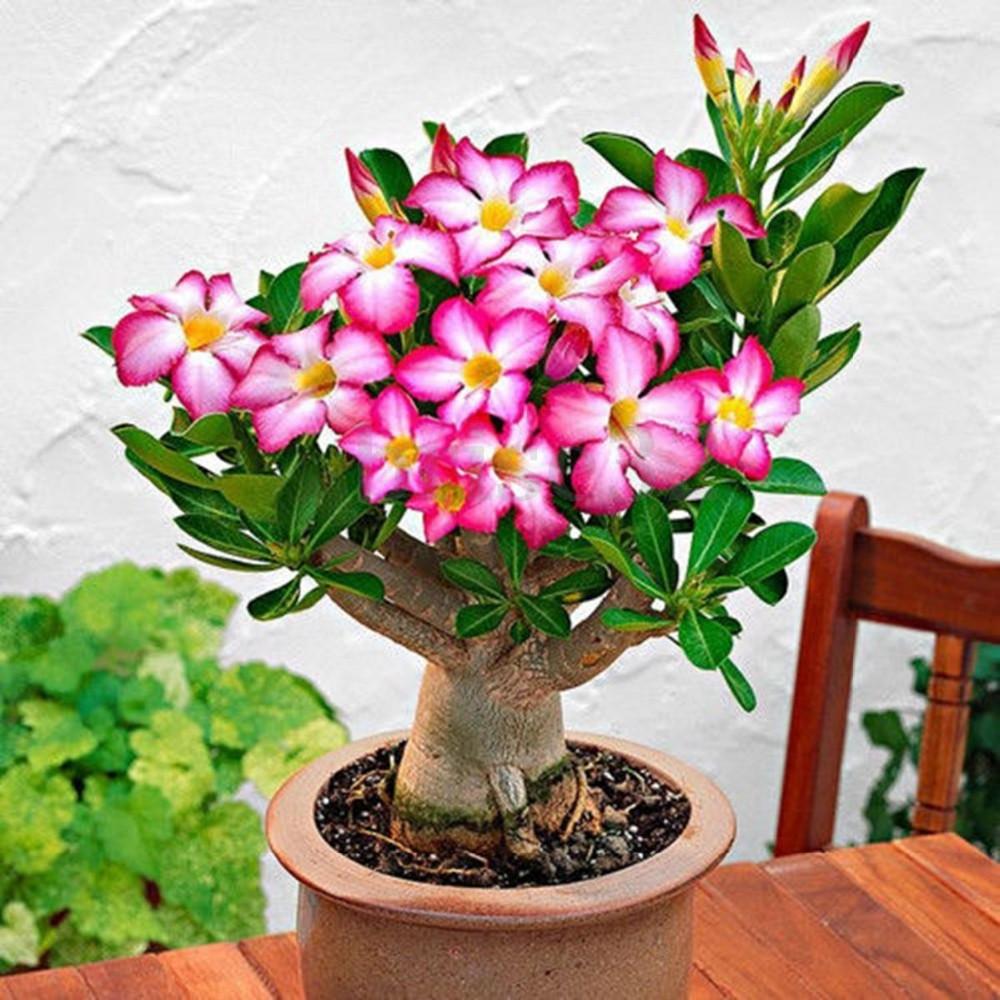
Adenium home care
Description of the plant
In nature, Adenium grows as a small tree or shrub up to 2 m in height. In apartments it does not exceed 60 cm. The trunk (caudex) is thickened at the base and resembles a barrel, from which branches with leaves extend in all directions.
It is the bizarre shape of the trunk and roots that makes Adenium a coveted item in the collection of bonsai art lovers.
The flowers are large, of various colors. Thanks to the efforts of breeders, varieties with buds of all shades have been bred. It begins to bloom after 2-3 years, and the duration is from 3 to 10 months. Not every house plant can retain its decorative effect for so long.
However, Adenium is beautiful even without flowers. With proper care and shaping of caudex, roots and branches, it is easy to get a wonderful living home decoration. An unusual shape is achieved through regular pruning and transplanting, as well as by using non-standard methods for shaping the trunk (splicing, weaving, etc.)
Varieties
The genus adenium includes 5 types:
- Boemianum;
- Multi-flowered;
- Obese (Somali);
- Olifolium;
- Swazicum.
Each of them has its own varieties. Not all of them are used for home breeding. Some can be seen only in greenhouses with conditions as close as possible to their natural, natural.
Mini
The variety was bred through long selection specifically for keeping in the house.
Bushes are compact, up to 20 cm in height, strongly branching, with succulent smooth leaves.
They bloom profusely and for a long time, but there are no terry varieties among mini adeniums. It reaches its maximum size by 5 years, it grows very slowly.
There are mini subspecies such as:
- Mini Size Red - red flowers with a dark border and a white core. Has a smooth transition from white to scarlet;
- Mini Size Sunup Star - small white and pink flowers. Among florists, the name of the subspecies "Morning Star" is widespread;
- Mini Size White is a recently bred variegated variety with large white flowers. The petals are even and symmetrical, with a cream border along the edge;
- Mini Size Pink - bright pink flowers with a white center. Closer to the edge of the petal, the pink shade is more saturated;
Mini adeniums differ not only in color and size of flowers, but also in leaves of different shapes. They can be straight and twisted, bent inward.
The mini-variety Richie deserves special attention - it is the most exotic. A dwarf tree with a thick trunk and an abundance of bright pink flowers attracts everyone's attention.
Crested
In some species, due to a rare mutation, a comb (crested) form is formed. It is most commonly found in cacti and succulents, but sometimes also in adeniums. Looks like a cockscomb.
A crested flower can be grafted, but they are bred in a nursery without a rootstock.
Growing is not easy. It is impossible to force the shoots to curl; this is laid down at the genetic level.
It is possible in the first year of the plant's life to be grafted with a cuttings of the appropriate variety. Then, by the age of 3, the flower will acquire the properties of a crested adenium.
Obese, or Somali
It got its name from the caudex shape - thickened downwards in the manner of a small barrel. It grows more often in the form of a tree; in the absence of pruning, it can grow near the ground, like a shrub. In nature, it is high, in an apartment it does not exceed 60 cm.
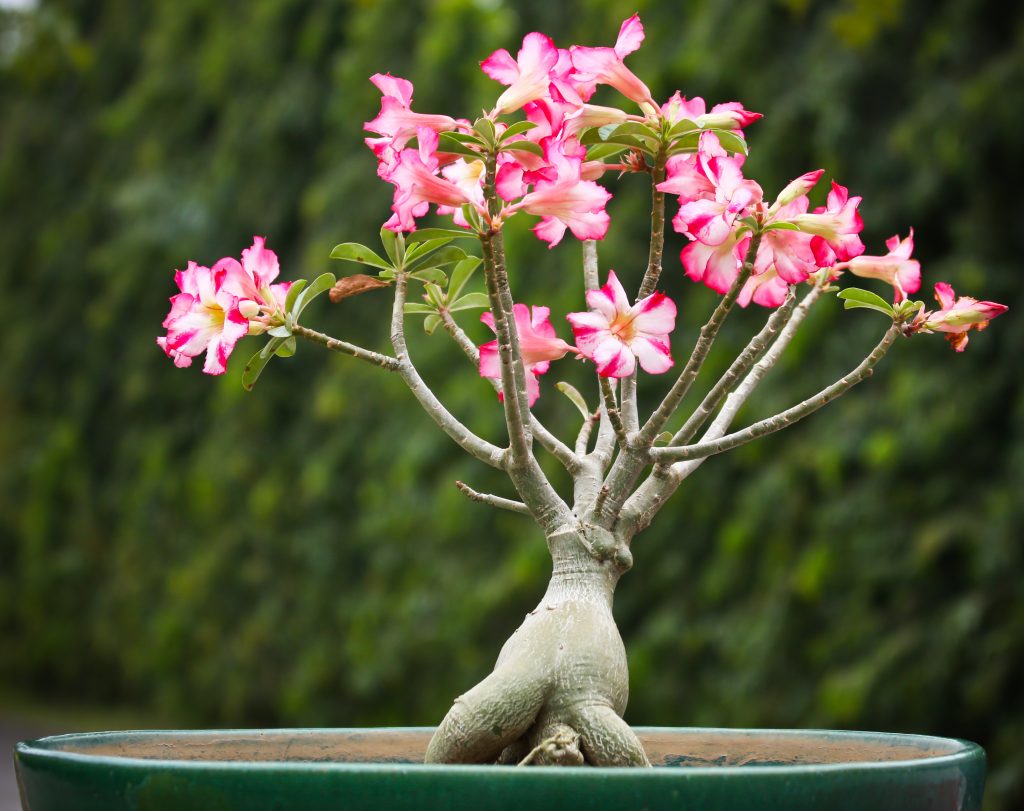
Adenium photo adenium photo
Leaves are long, lanceolate, placed on short petioles alternately. They have a smooth, glossy surface. The shape of the flowers is funnel-shaped, the color is scarlet. The buds have no smell.
Various varieties of obese adenium have been developed.
Simple:
- Candy;
- Black Fire;
- Sarah
Terry:
- Quatro (each flower has 4 rows of petals) - Golden Rose, King Rose, Dark Lord;
- Triple (petals in three rows) - Amazine Rose, Anna;
- Double (2 rows of petals) - Moon Sprey, Devine Creation.
Arabicum
Most often used for bonsai, due to the shape of the trunk and branches.
The caudex is very thickened, roots protruding from the ground, making the plant look like an alien creature. The bark is smooth, light, and resembles skin in texture. The flowers are large, from pink to red.
At home, it sheds foliage in late autumn and blooms in early spring.
Flowers bloom during a period when the tree has not yet grown green mass. It looks like a bright bouquet on a bare trunk and branches. Looks original and unusual.
Socotransky
In nature, this is the largest form of adeniums, externally resembles a baobab with a thick trunk and small-leaved crown. It grows in the Arabian desert, where it reaches 5 meters in height and almost the same is the width of its trunk.
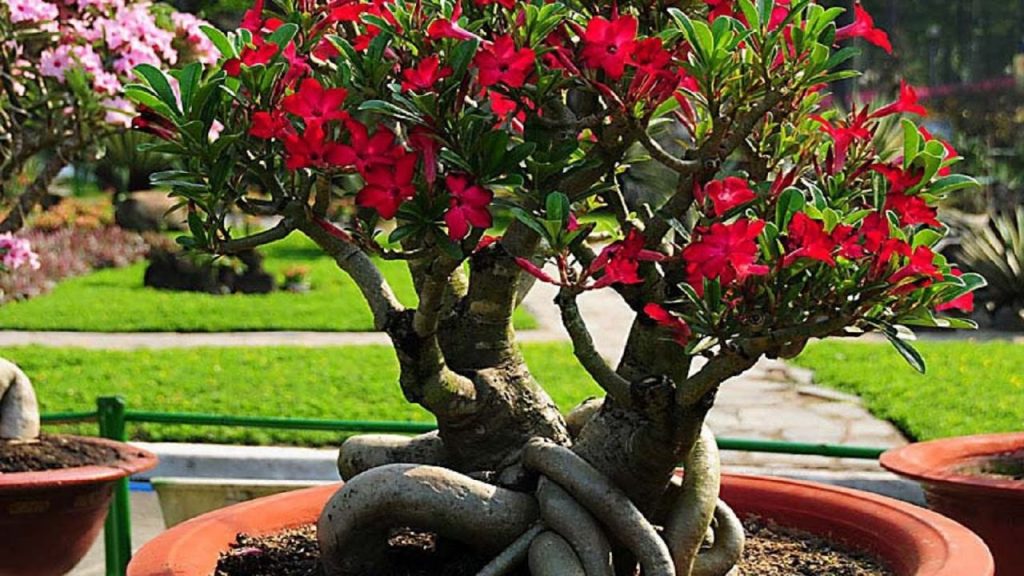
Adenium home care care
At home, it is rare due to the difficult conditions of detention. This variety requires a high temperature (at least + 27 ° C all year round) and bright lighting, otherwise the plant will bend, the thick trunk becomes ugly, flowering does not occur.
Adenium Bema
The most poisonous variety. Since ancient times, its poison has been used to rub arrows before hunting. Some tribes in Namibia still do this. The poison is very strong and fast-acting.
Despite this, Bem's adenium is grown at home by exotic lovers.
The species is unpretentious, blooms in the 3rd year of planting in winter. The leaves are corrugated, with wavy edges. It looks impressive even without flowers. It propagates well by seeds that ripen even in apartment conditions.
Attention! Always use heavy gloves when handling the flower.
Purchase and adaptation
If the plant went on sale from abroad, it should definitely be kept in quarantine for 3-4 weeks. You cannot immediately put it on the rest of the indoor flowers - there is a risk of infection with a bacterial and viral infection. It will be problematic to cure all the plants later.
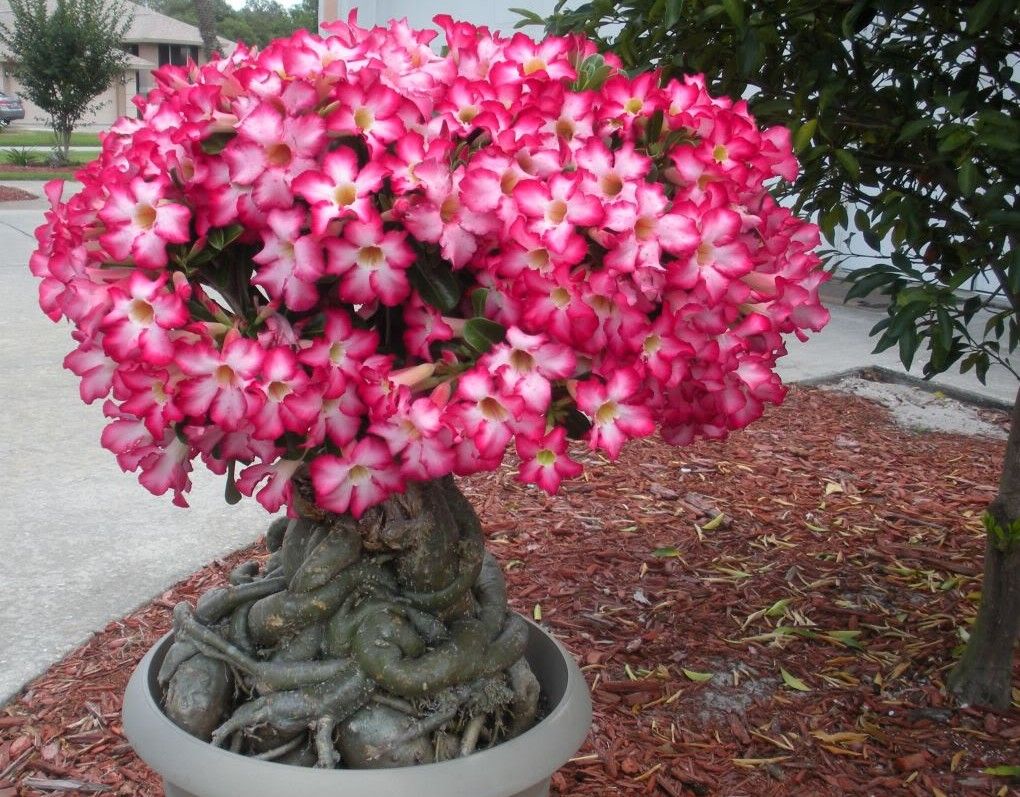
Adenium flower
Especially careful handling is required by Adenium, purchased already by adults, flowering.
Young cuttings grown in the same area where they were purchased are already adapted to the local climate. However, the risk of infection remains.
Having brought such a flower home, you need to keep it separately for about two weeks, watch the growth, development.Watering, feeding, pruning is excluded until the end of the adaptation period.
Planting and transplanting
Growing adenium up to 3 years old has to be transplanted often. Roots require a lot of nutrients and space, they will not develop normally in the same container.
Transplantation is one of the methods of caudex formation, but this will be detailed below.
These flowers are "inhabitants" of deserts, rocky areas and plateaus with poor sandy soils. The composition of the soil for the plant is the same as for cacti and succulents: it must quickly absorb moisture and be light for better root growth.
The capacity should be wide and low - this way it will be possible to form the desired shape of the trunk and roots.
Landing technique:
- A larger drainage is laid in a pot on the bottom, then a substrate of earth, perlite, vermiculite and coarse sand.
- They place the tree in the ground and gently and shallowly add it. The roots should show a little above the surface.
- Water a little, then put in a warm place and no longer water for at least 2 weeks. Roots need time to start up the small lateral "capillaries" necessary for nutrition.
The flower will have enough moisture from the fleshy trunk. After 2-3 weeks, watering is voiced and transferred to normal mode.
Growing conditions
Seat selection
South windows are the best place in the room for adenium. There will be little light on the eastern and western flowers. The northern ones don't fit at all. We'll have to supplement lighting and heating it additionally, which is not very convenient.

Adenium home care photo
Humidity and temperature
Adeniums prefer high levels of humidity, but only in conjunction with high temperatures. This is the main difficulty.
Ideal conditions in summer are + 30 ° С and humidity 70%. However, it is difficult to create such a microclimate in an ordinary city apartment.
Florists are guided by a simple principle: the lower the temperature, the lower the humidity.
At normal room values of + 22-25, the humidity is maintained at 50%. This requires additional measures - trays with water around the flower, irrigation 1-2 times a day, some put a humidifier.
As soon as it gets colder - below +22 ° С - the humidity is immediately lowered.
However, if you keep the high temperature and humidity in the summer, there is no way at all, then it is better not to keep adenium at home - it will develop poorly, hurt and will not please with its healthy blooming appearance.
Even the most unpretentious varieties require at least a lower temperature threshold in summer (+22 ° С) and in winter (+16 ° С).
Illumination
The plant loves light. Even a direct sun will be preferable for him to partial shade.
However, the trunk is the "weakest" point. Sometimes, if the sun is too hot, the flower is shaded precisely because of the risk of burning the caudex. Its surface is very delicate and requires special care. Excessive backlighting will harm him.
The light should not only be sufficient, but also uniform. On the windowsill, the flowerpot will have to be turned periodically so that the plant does not stretch in one direction. In summer, it is allowed to take a flower out into the garden - so the lighting will be the same for all sides of the crown. In the rain and at night, the flowerpot is removed back into the house.
Home care
Adenium is capricious, this exotic requires increased attention. But with proper handling, it can grow and bloom for months without problems in an ordinary apartment.
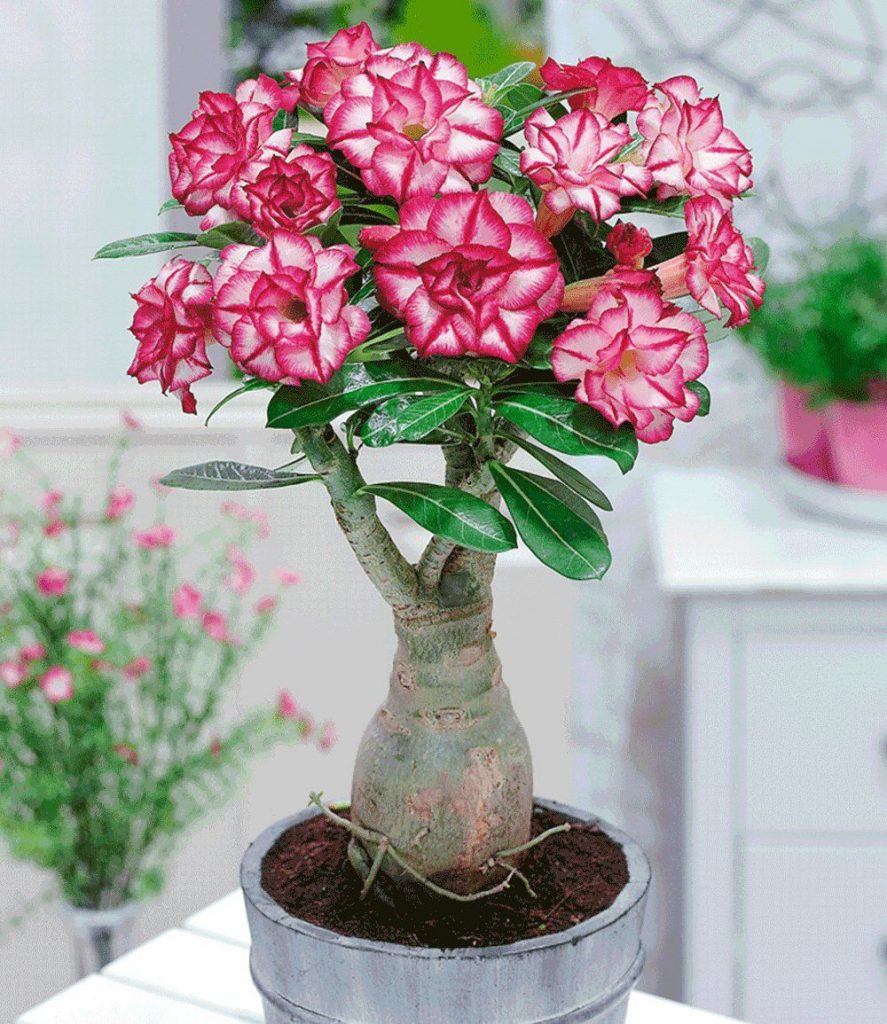
Adenium flower photo
Watering
For a flower, water is specially defended for at least 3 days. Some enthusiasts only collect rainwater to irrigate adenium.
Not watered too often, but abundantly. To allow water to flow out of the drain holes. It is not necessary to heat it on purpose - it is even better if the water is slightly cool.
The main thing is not to leave excess moisture in the pallet: as soon as everything drains, it is wiped dry and put back under the flower.
Watering frequency depends on temperature and season.
- In summer, the flower is watered once a week.
- In winter, during the dormant period, you can not water for a month or more.
Fertilizers and feeding
Fertilize adenium at least once a month during the active period. Both mineral and organic feedings are suitable.
You should be careful with the latter, they strongly affect the growth of soil microflora. Not always auspicious. Especially if the air temperature rises.
But natural dressing immediately gives the result - the plant grows rapidly, more buds bloom, flowering is lengthened. The tree has more vitality to grow and give beauty.
Best recipes:
- Chop the banana peel, dry and add to the top layer of the substrate;
- The coffee grounds (you can use sugar) are mixed with the potting medium;
- Dissolve chicken or pigeon droppings in water (2 tablespoons per 1 liter of water). Insist covered for 2 days, pour under the roots of the plant;
- Pour onion peel (50 g) with 1 liter of water, bring to a boil, boil for 5 minutes, turn off and cover. Insist 3 days. Strain and water the plant with broth. You can spray the leaves - this will also be a prophylaxis against pests.
Of the ready-made mineral complexes, the following are most suitable:
- Osmocote Bloom (granules)
- Plantafol (nitrogen 10%, phosphorus 54%, potassium 10%, B, Cu, Zn, Mn, Fe, Mo;
- Superthrive (vitalizer + fertilizer growth stimulator);
- Etisso Universal (A-F-K 6: 5: 6)
The main thing is to choose one type of feeding, and not use several at the same time. Organic and mineral fertilizers must never be mixed. They need to be correctly alternated, based on the composition of the soil, variety, season and microclimate in the house.
Features of winter care
Wintering is a difficult time, as well as for its owners. The flower needs a dormant period, but with sufficient lighting and a temperature of at least +15 ° C. At the same time, humidity should be minimal, but it is not easy to achieve such parameters in an ordinary apartment.

Adeniums
If you put a flower on a windowsill, it will feel hot from the hot air rising up from the radiators. If you move deep into the room, there will be little light. Dry air will begin to dry out the roots, but watering is often impossible - this way he will not be able to fully rest. Most of the seedlings die in florists during this period.
Ideal conditions in winter:
- +15 ° С - for first years;
- + 13-14 ° С - for older flowers.
With a completely dried earthen coma, the plant can withstand a short-term drop to + 10 ° C, but it is better not to experiment this way.
In early spring, the flower is gradually brought out of dormancy. The temperature is gradually raised, they begin to water a little. The flower itself will give a sign when it starts to wake up - young leaves will appear from the buds. So, you can feed him a little. Give him strength to wake up from winter sleep.
Reproduction methods
It is not difficult to multiply adenium, but it is important to do everything on time and correctly. True, the further preservation of varietal traits is controversial. Especially if you sow seeds harvested from your plant after flowering.
Seeds
The seed should be as fresh as possible. The seeds are pre-soaked in growth stimulants (Energen, Fitosporin M, Ecopin) for 6 hours. Then, seeds are placed in the prepared mixture of perlite and vermiculite and lightly sprinkled on top. Pour warm water from a syringe and cover the container with a film.
A homemade greenhouse is placed from a warm place to the light. The temperature should be + 26-29 0С. Seedlings appear quickly - after 7-10 days. However, at the next stage, 2/3 of the weakened and deformed shoots are eliminated. It is important to maintain the correct level of heat and humidity, as well as lighting, so that the sprouts do not stretch or curl.
Important! Wipe off drops of condensation from the film on a regular basis so that the seedlings do not rot.
Open the greenhouse no earlier than a month later, when the seedlings get used to the microclimate in the house. They teach them to do this gradually. First, open the film for 2-3 hours a day, then twice a day. After 2-3 months, they begin to look after the seedling like an adult.
Apical cuttings
In spring and summer, the plant is propagated by cutting off several apical cuttings. During planned pruning, parts of the branches remain that root well under certain conditions. Dip the cutting in Kornevin for an hour, then place it in the substrate and cover with a jar.
The substrate is prepared in advance, it should be as loose and light as possible. At elevated temperatures (+ 27 ° C), the cutting will take root quickly, in 2-3 weeks. This time it should not be watered or sprayed to avoid decay. The jar is removed from above in a month, by which time the stalk will have hardened, rooting will become more reliable.
Air layering
A laborious and risky method of propagation, however, it gives the best chance to preserve the varietal properties of the plant. An incision of 1-2 cm is made on the shoot around the entire circumference. The wound is dried, treated with Kornevin. The incision is covered with moss and tied with foil.
Moss the moss as it dries and keep the plant warm. Roots begin to form at 3-4 weeks. When they are sufficiently developed, the cuttings are cut off and placed in the ground. The wound on the branch is treated with "Fundazol" or "Chlorhexidine". Copper preparations - "Oxyhom" and "Kuproksat", dry the cut well and prevent the penetration of microbes.
Layers grow well in a light substrate, but their decorative effect is lower than that of the mother plant. Caudex will not be as thick, it will not work out of it to grow a full-fledged bonsai. However, the method of reproduction does not affect flowering in any way. Air layers planted in the ground bloom in the same way as flowers grown from seeds.
Caudex formation
The most decorative part of the plant is the powerful trunk (caudex). It is not easy to form it, this must be done from a very early age of the flower and not to miss a single intermediate stage.
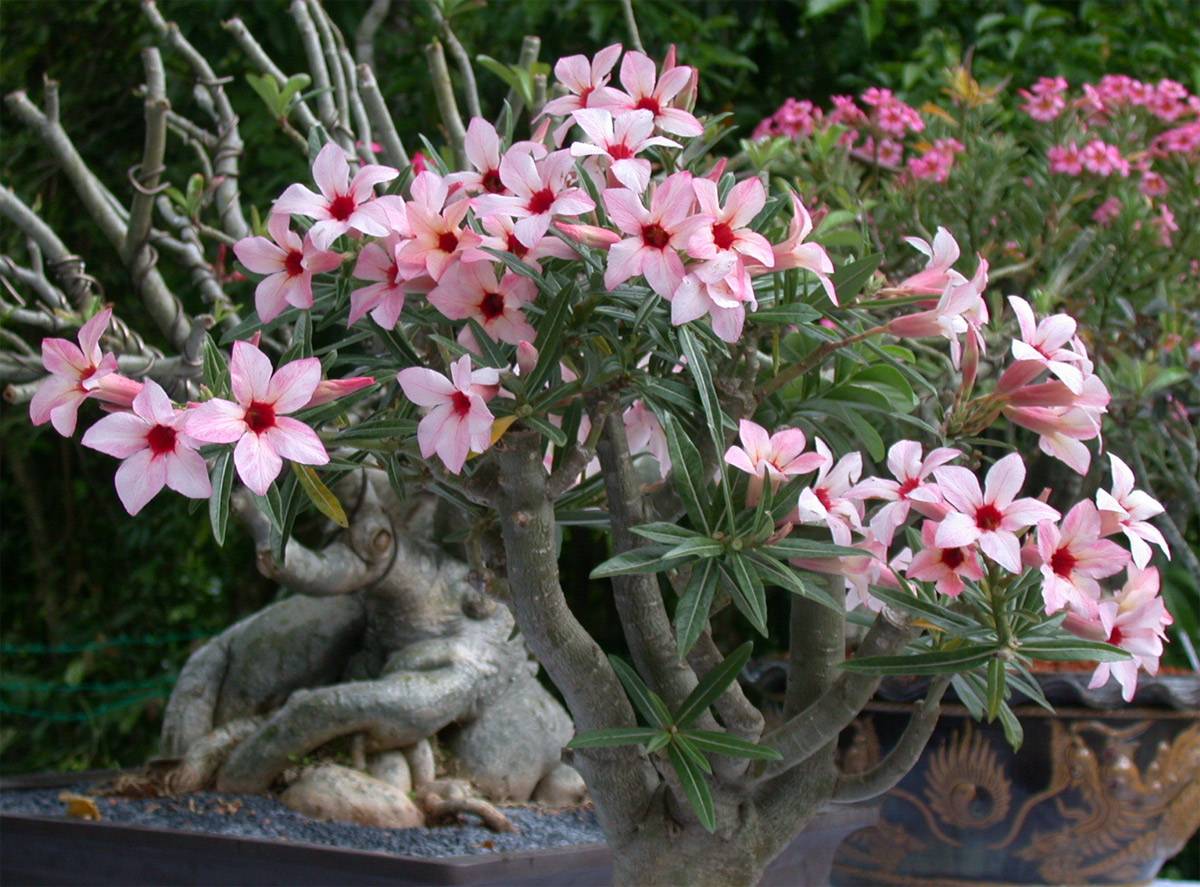
Adenium photos
Pruning crown and roots
The thickness of the trunk and branching of the roots will directly depend on the splendor of the crown of the tree. In the first 3-4 months, pinching of the upper kidneys is done. This can be done manually, without any tools at hand. The buds or rudiments of young leaves are removed; in their place, two new buds will form later. The crown will branch out.
Roots also form in the first six months of a flower's life. The first thing to do is to remove the central root in order to stimulate the growth of the lateral ones. If you tighten up with this, the root will stiffen and become more difficult to remove. After 2 years, carrying out this procedure is dangerous for the plant.
When pruning the crown and forming roots, the caudex itself will thicken and grow in breadth. The first 6-10 months do pinching, later - full pruning. Often, the central trunk is cut to stimulate the growth of side shoots. At the same time, the caudex stops growing upward, but begins to thicken and take on bizarre shapes.
Splicing multiple trunks
Allows you to get the most intricate forms of caudex. Immediately after germination from the seeds, the sprouts are planted together in one container and the stems are tied. After 2 months, the bandage is removed, and incisions are made at the contact points of the seedlings. The trunks are tied together and tied again with foil.
After a month, the bandage is removed again. During this time, plants in close contact manage to grow together firmly. At the same time, Caudex takes on an unusual shape, which cannot be achieved by simple pruning of the crown and roots. Most interesting of all. If you merge adeniums of different varieties. At the same time, flowering will be unusual - multi-colored, with double and smooth flowers on one tree.
Extreme root pruning
Experienced growers form caudex using the extreme pruning method. First, the central root of a young plant is removed and all the others going down. A plastic circle is laid on the ground to the diameter of a young trunk. Adenium is placed on a circle, the lateral roots are straightened along the edges of the circle and sprinkled with soil.
The adenium itself is fastened with props - sticks or knitting needles so that it does not fall. It is time consuming and risky.It is important to monitor the moisture content of the soil - it should be slightly damp all the time, but not wet. The roots will begin to grow into the soil and thicken, the caudex will also grow in breadth. This will form an unusual form of adenium called "octopus".
Diseases and pests: treatment and prevention
| Problem | Symptoms | Treatment | Prophylaxis |
| Bacterial burn | Leaves turn yellow, fall off | Remove damaged leaves, spray the plant with a weak solution of potassium permanganate, water the soil with the preparation "Baikal EM" | Do not overmoisten the air and soil |
| Caudex rot | Threw off the leaves, the trunk grows soft | Cut off the decayed part of the trunk along with the roots, root again | Do not overmoisten the air and soil |
| Root worm | Leaves turn pale, dry and wrinkle | Confidor, Aktara three times with an interval of 5-10 days | Disinfect the soil before planting, inspect |
| Mealybug | White cotton bloom on leaves and trunk | Wash off with soapy water, Aktara, Kofidant, Kofinor | Inspect regularly |
| Spider mite | Leaves turn pale, cobwebs in sinuses | Fitoverm, Anti-tick, Mosai, Borneo | Inspect regularly |
| Shield | Leaves curl and fall | Aktara, Aktellik, increase the temperature, reduce humidity | Inspect regularly, do not overmoisten |
Adenium of any kind will become a real decoration of your home flower collection. If it is possible to recreate the microclimate of desert latitudes, then the plant will live and bloom for more than 100 years. There are species that live up to 200 years or more. Courting is not easy, but interesting, and the result will not leave anyone indifferent.

